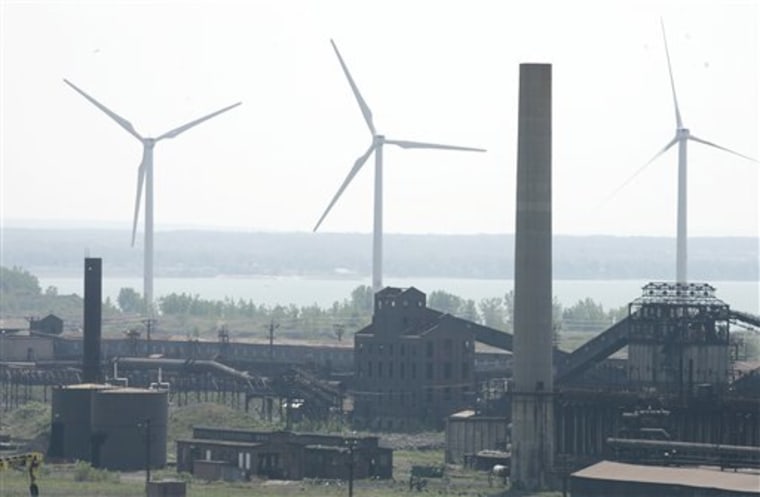An "urban" wind farm has sprouted along a stretch of Lake Erie too polluted for much else.
Eight towering turbines slowly spin near old smokestacks and other industrial remnants on a waterfront site where Bethlehem Steel once stood tall with 25,000 employees.
"It's quite a contrast," said Norman Polanski, mayor of this city south of Buffalo, "the old rusting away while the new rises above it."
Rise they do. Each of the 2.5-megawatt turbines is 400 feet tall — higher than a 30-story building — with a trio of blades each 144 feet long.
The model "is one of the biggest land-based turbines in the world," Paul Gaynor, president and chief executive of Newton, Mass.-based UPC Wind, said Thursday as the Steel Winds project neared the end of its first week of commercial operations.
With eight turbines, Steel Winds is a relatively small wind farm, producing enough electricity for about 6,000 homes, but it is giving UPC and partner BQ Energy of Patterson a valuable first look at the new Clipper Liberty 2.5-megawatt turbine, Gaynor said. For the last five years, typical turbines have been 1 to 1.5 megawatts.
"We know how to build them now, we know how to transport them and we're learning how to operate them," Gaynor said.
The rise of the $40 million project has been a lesson, too, for residents of this Rust Belt city who have lamented the lack of activity on the waterfront since the steel plant began its decline 30 years ago. Today, the steel business employs only about 268 people, at a finishing mill operated by Mittal Steel. Mittal acquired the operation in a merger after Bethlehem Steel sold its assets in bankruptcy to International Steel Group in 2003.
Residents now see that new development is possible, Polanski said.
"This has been the first positive change on the waterfront and you can see it anywhere you are on the waterfront," said Polanski, who lost his Bethlehem Steel job when the plant closed in 1983.
And while the wind project will bring the city $100,000 a year for 15 years under a deal with developers and employ a small number of people, the larger impact is on attitude, the mayor said.
"Change is in the air," he said. "You can see it and you can feel it and the confidence level for the people is up there. It has changed the attitude of people here."
The windmills were constructed on top of slag left over from the steel-making process. Also unusual is its presence in a city, far from the rolling rural locations of most other wind farms in the country.
It was the wind off of Lake Erie that made the location attractive, Gaynor said. It turned out to be too much of a good thing during installation of the turbines, which was frequently delayed by high winds.
